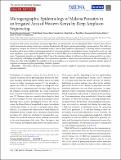| dc.contributor.author | Elizabeth Hemming-Schroeder, Daibin Zhong, Solomon Kibret, Amanda Chie, Ming-Chieh Lee, Guofa Zhou, Harrysone Atieli, Andrew Githeko, James W Kazura, Guiyun Yan | |
| dc.date.accessioned | 2022-01-31T07:23:35Z | |
| dc.date.available | 2022-01-31T07:23:35Z | |
| dc.date.issued | 2021 | |
| dc.identifier.uri | https://repository.maseno.ac.ke/handle/123456789/4792 | |
| dc.description.abstract | To improve food security, investments in irrigated agriculture are anticipated to increase throughout Africa. However, the extent to which environmental changes from water resource development will impact malaria epidemiology remains unclear. This study was designed to compare the sensitivity of molecular markers used in deep amplicon sequencing for evaluating malaria transmission intensities and to assess malaria transmission intensity at various proximities to an irrigation scheme. Compared to ama1, csp, and msp1 amplicons, cpmp required the smallest sample size to detect differences in infection complexity between transmission risk zones. Transmission intensity was highest within 5 km of the irrigation scheme by polymerase chain reaction positivity rate, infection complexity, and linkage disequilibrium. The irrigated area provided a source of parasite infections for the surrounding 2- to 10-km area. This study highlights the suitability of the cpmp amplicon as a measure for transmission intensities and the impact of irrigation on microgeographic epidemiology of malaria parasites. | en_US |
| dc.publisher | IDSA | en_US |
| dc.subject | Plasmodium falciparum, irrigation, transmission intensity, amplicon sequencing, microgeographic epidemiology, infection complexity | en_US |
| dc.title | Microgeographic Epidemiology of Malaria Parasites in an Irrigated Area of Western Kenya by Deep Amplicon Sequencing | en_US |
| dc.type | Article | en_US |

